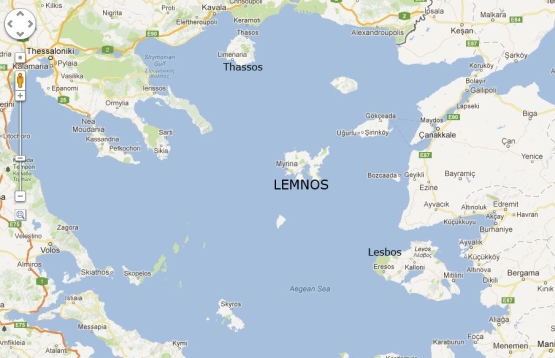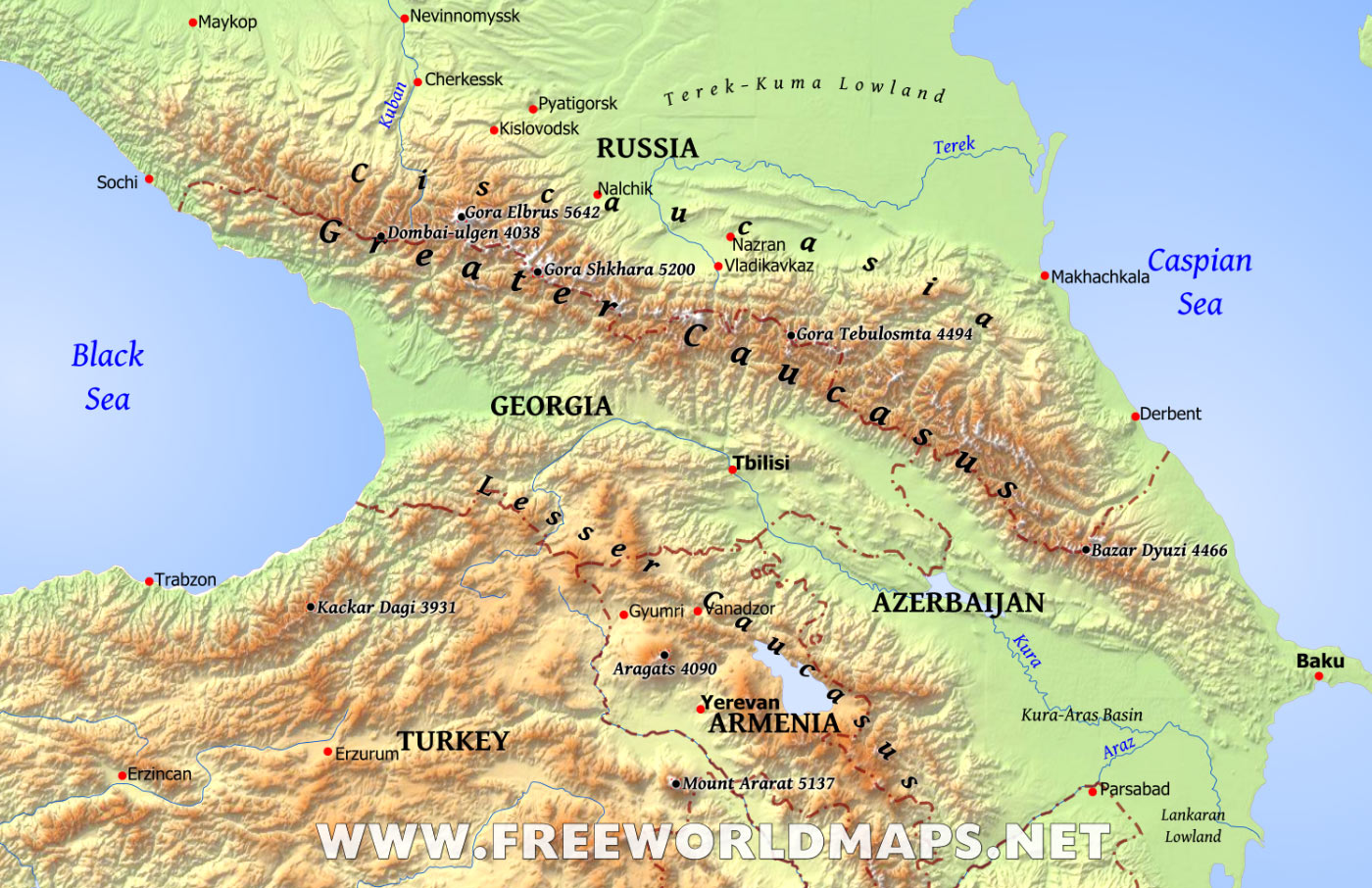November 1918, came a week after, first, the Mondros
Armistice was signed on 30 October and, second, after
Turkish leaders Enver, Talat and Cemal fled Istanbul
on 1 November to Sevastopol aboard a German warship.
The bloody battles of Dagestan, written about in detail
by Colonel Mehmed Tevfik a year after the battles in
1919 (and published in 1927), and presented here in 11
parts by TNT, reflect the horrors of war, the courage of
warriors and, in this case, the futility of the efforts of
the Islamic Army of the Caucasus. Nevertheless, the
IAC's success in the Caucasus was one of the few
military bright spots for the Ottomans in WWI, but,
alas, a forgotten one.
Because with the end of the War, the Turks withdrew
from this remote corner of the Great War's stage
and the Bolsheviks/Soviets eventually claimed control
over all of the Caucasus, snuffing out the fledgling
Moslem republics there and Enver's dream of a Pan
-Turkic empire stretching to back to Turkish origins
in Mongolia.//
Treaty of Mondros click here for more information.

Far away from Dagestan, the Mondros Armistice was signed
on 30 October 1918 on the British warship Agamemnon in
the harbor of Mondros (also 'Moudros') on Lemnos Island.
At 2 o’clock on 8 November, a delegation of leaders came from the city
to the Division HQS, saying that Bicherekhov had left the city and that
the populace had begun to loot. They requested that the Turkish Army
occupy the city. Based on an order from the Army, at 4:30 o’clock in
the afternoon the triumphant 15th Division formally entered the city
in parade formation and settled into the barracks in the south of the city.
In the course of the 2-day Tarki battle, 10 officers were wounded,
including the Division Commander, two regimental commanders, a
battalion commander and 6 company commanders. Five officers
were martyred, including 3 company commanders. As for the soldiers,
318 were wounded, 113 were martyred and 10 are missing.
It is thought that more then 200 of the enemy were killed during the
pitched battle.The 15th Division brought great honor upon itself by
cleansing the land of Azerbaijan and the Northern Caucasus of the
enemy, ensuring security and order, and thereby allowing the
governments to establish themselves. This Division, after coming to
Baku from Gemri, had combined with the 5th Division to successfully
attack Baku. It is certain that without the 15th Division, Baku would
Battle of Baku: Turkish forces represented by the
arrows heading toward Baku from the north and
west on 14 September 1918.
Following this success, the 15th Division cleansed the land from Baku
to Petrovsk of the enemy in one short month and thereby provided
enormous support to the brotherly peoples of Azerbaijan and the North
Caucasus, in the name of the Turkish nation.
In addition, the self-sacrifice and courage the Division displayed in the
Baku, Derbent and Petrovsk attacks deserve to be written in gold letters
in our military history. Even after four years of war and great
deprivation, the Turkish Army proved by the good order and bravery
shown during these battles that it is the finest attacking army in the
world.
shown during these battles that it is the finest attacking army in the
world.
All the troops of the Division performed their duties properly and, in
particular, the heroic 56th Regiment is deserving of the title of Liberator
of Baku, Derbent and Petrovsk.

On the right: Baku, Derbent, Makhachkala (Petrovsk).
The officers and commanders, together with the senior commanders,
performed their duties well. The Division’s general staff worked
continually with organization, effort and self-sacrifice to ensure transport,
food, provisions and all other services and is deserving of the gratitude
of the entire Division.
The post-Derbent operation was administered with great shrewdness and
courage by Yufuf İzzet Paşa. The speed and bravery exhibited by the
15th Division after Derbent and during the assault on Petrovsk would not
have been possible with Yusuf İzzet Paşa’s impact and influence.
The extension of the operation to Petrovsk, after Derbent, and the
seizure of Baku were appropriate with regard to completing the
mission. With the armistice (Mondros, 30 October 1918), the Turkish
nation plunged into an especially painful situation. Nevertheless, would
it have been possible to abandon the mission of liberating our
brotherly nations while there still were the means to press on?
seizure of Baku were appropriate with regard to completing the
mission. With the armistice (Mondros, 30 October 1918), the Turkish
nation plunged into an especially painful situation. Nevertheless, would
it have been possible to abandon the mission of liberating our
brotherly nations while there still were the means to press on?
Although the operations in Azerbaijan and, in particular, in the North
Caucasus, proceeded quickly, this coincided with the mother country’s
dangerous situation. And since the Caucasus had to be immediately
evacuated because of the armistice, the Turkish Army’s support for the
Caucasus Turks and Moslems and the extraordinary self-sacrifice it
exhibited in the face of enormous challenges has all but been forgotten.

The leaders of the short-lived Northern Caucasus Republic

The leaders of the short-lived Northern Caucasus Republic
Evacuation of the Northern Caucasus
Bicherekhov had not accepted the demand that he evacuate the land of
the North Caucasus and so, as has been described above, he was
attacked on 4/5 November 1918 and fierce fighting continued on 5/6
November.
the North Caucasus and so, as has been described above, he was
attacked on 4/5 November 1918 and fierce fighting continued on 5/6
November.
Following the seizure of Tarki Mountain, a delegation from
Bicherekhov requested a break in hostilities, in accordance with the
armistice (Mondros). Because of this preference for a political solution,
the fighting ended. The Prime Minister and Minister of War İzzet Paşa
ordered that all materiel in the Caucasus, other than that which had
been authorized by the Brest-Litovsk Treaty, be removed within 6
weeks, beginning on 24 October. This telegram-order was written in
Istanbul on 26 October, received in Baku on 5 November and delivered
to Yusuf İzzet Paşa in the vicinity of Petrovsk a few days later.
Bicherekhov requested a break in hostilities, in accordance with the
armistice (Mondros). Because of this preference for a political solution,
the fighting ended. The Prime Minister and Minister of War İzzet Paşa
ordered that all materiel in the Caucasus, other than that which had
been authorized by the Brest-Litovsk Treaty, be removed within 6
weeks, beginning on 24 October. This telegram-order was written in
Istanbul on 26 October, received in Baku on 5 November and delivered
to Yusuf İzzet Paşa in the vicinity of Petrovsk a few days later.
Relative to the number of troops to be transported, the railway capacity
was insufficient and because of the long distances involved, evacuation
within the allotted time frame was impossible. There were not enough
means available to transport all the troops right away. It would require
three trips to transport the materiel involved to Batumi. Since it was
necessary to begin the evacuation with the troops farthest away, a
sufficient number of emptry trains were sent north from Baku on 9
November to transport the materiel and troops at Petrovsk.
was insufficient and because of the long distances involved, evacuation
within the allotted time frame was impossible. There were not enough
means available to transport all the troops right away. It would require
three trips to transport the materiel involved to Batumi. Since it was
necessary to begin the evacuation with the troops farthest away, a
sufficient number of emptry trains were sent north from Baku on 9
November to transport the materiel and troops at Petrovsk.
On 12 November, the mountain ‘obüs’ battery was transported and on
17 November the 46th Battalion of the 13th Regiment and the 5th
Division’s health company were sent. The transport of the 15th Division
from Petrovsk did not begin until 22 November. With the last remnants
of the 15th Division passing through Bilecari station, north of Baku, on
29 November, the North Caucasus had been completely evacuated by
Turkish troops at the end of November 1918.

//End of Part XI/FINAL//
17 November the 46th Battalion of the 13th Regiment and the 5th
Division’s health company were sent. The transport of the 15th Division
from Petrovsk did not begin until 22 November. With the last remnants
of the 15th Division passing through Bilecari station, north of Baku, on
29 November, the North Caucasus had been completely evacuated by
Turkish troops at the end of November 1918.
//End of Part XI/FINAL//


Hiç yorum yok:
Yorum Gönder